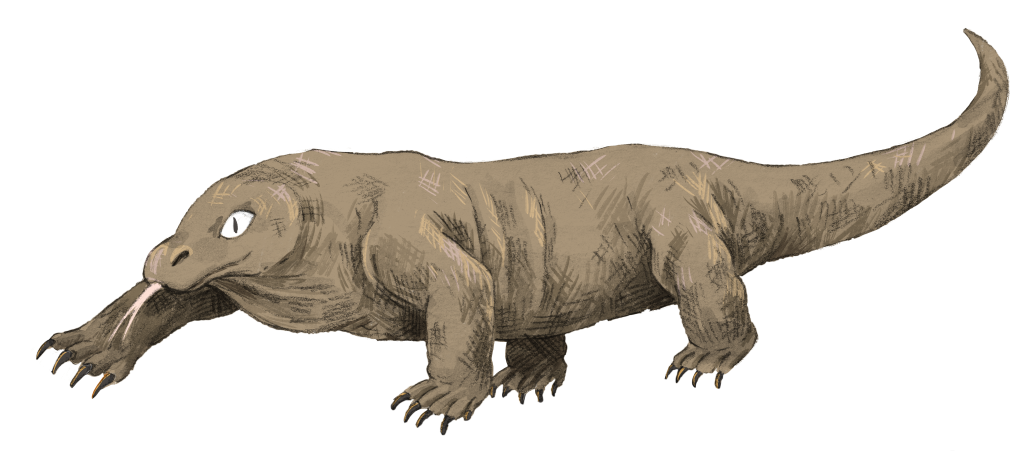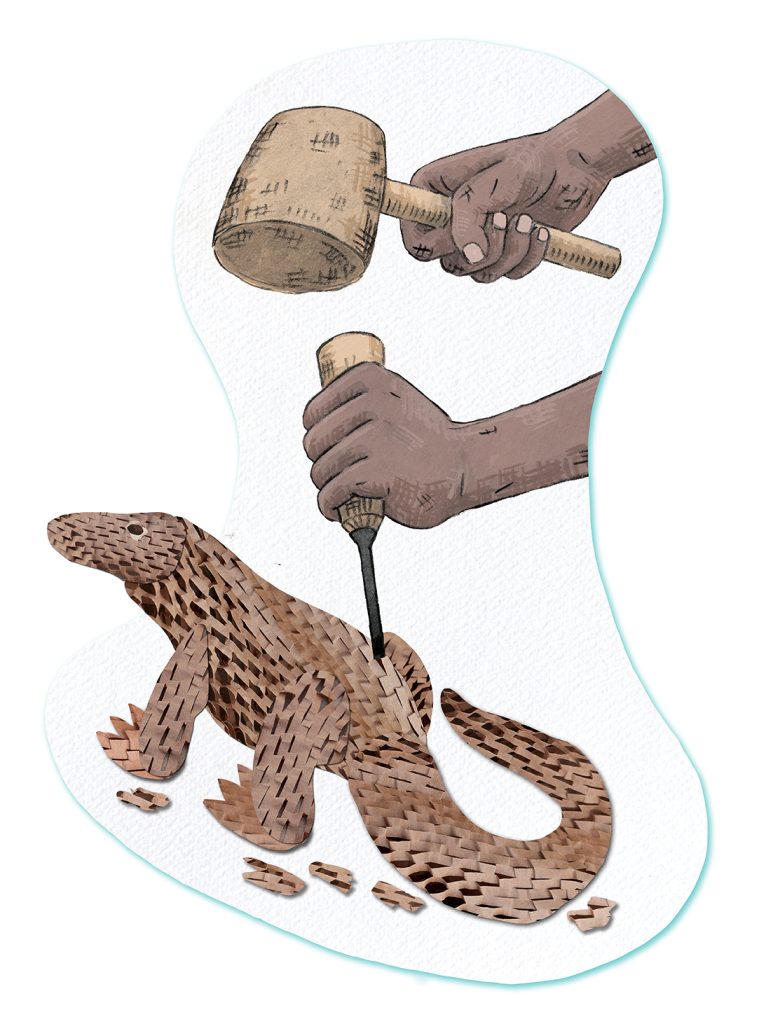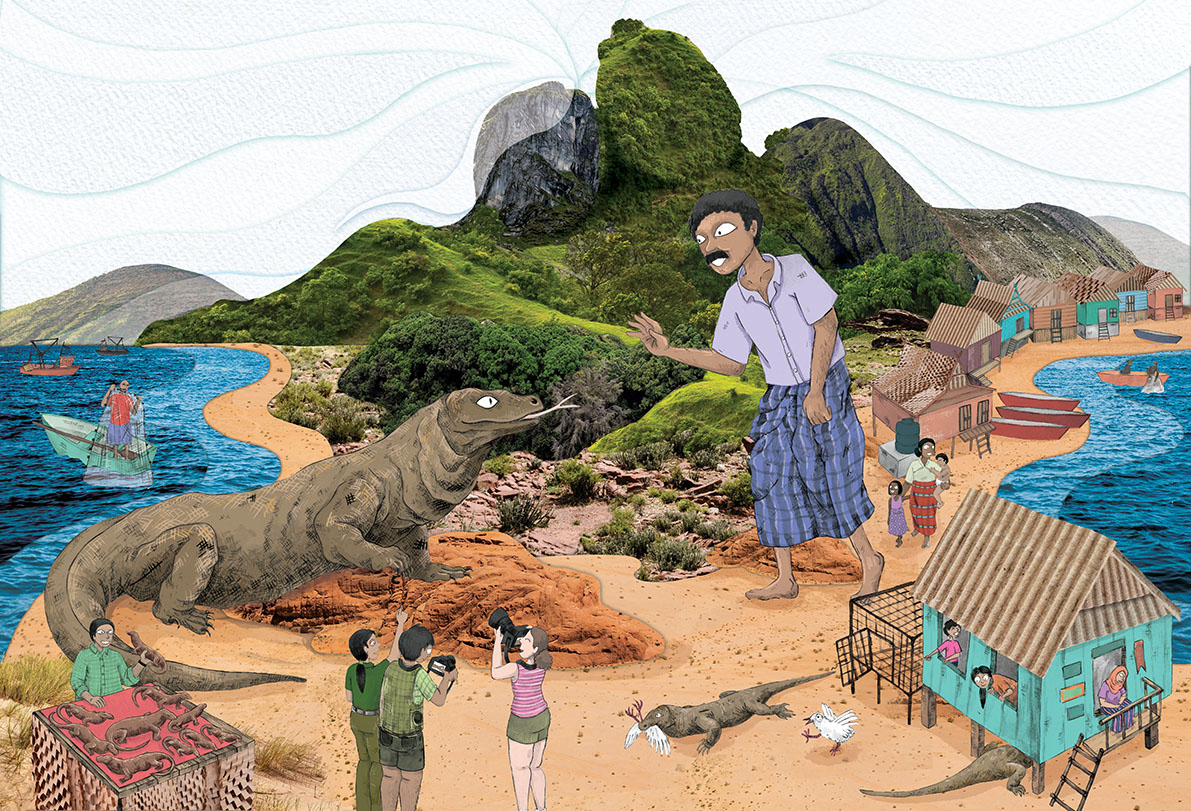“Ndadi manga waing di sa ro losa anaq rua. Pusi sa kenobo ndadi ora, sa kenobo ndadi manusia.”
“On a fateful day, two children were born. One, an Ora (Komodo), and the other, a human.”
– J. A. J. Verheijen
Human-wildlife coexistence entails recognising the importance of sharing our space with wildlife. Achieving a sustainable, lasting coexistence can be challenging, particularly when dealing with formidable predators that may pose risks to human safety. Yet, an extraordinary exception to this is found in Komodo village, located within Komodo National Park. In this community, people live in harmony with awe inspiring Komodo dragons (Varanus komodoensis)—the world’s largest and iconic lizard found only in Indonesia.
Komodo dragons are remarkable giants, reaching lengths of up to three metres and weighing as much as 100 kilograms. As the apex predator, they are capable of hunting down large prey species like deer, wild pig, horse, and even buffalo, using a stealthy wait-and-ambush tactic. Their bites are venomous and contain infectious bacteria, causing slow and agonising death for their prey. Komodo dragons are well protected in the Komodo National Park, which harbours approximately 70 percent of the global population, according to the IUCN Red List 2019 assessment. Their solitary and cannibalistic nature, coupled with their remarkable sense of smell and the female’s ability to give birth without mating, continues to captivate imaginations worldwide.
For centuries Komodo villagers, locally known as Ata Modo, have shared their lives with the dragons. According to a 2022 national park survey, around 50 percent of the park’s Komodo population, equivalent to 1561 individuals, are concentrated on Komodo Island, where the Ata Modo reside. Encounters with these creatures are routine, when villagers venture into the forest or the dragons wander into the village.

While such encounters are typically harmonious, there have been instances of negative interactions between Ata Modo and Komodo. The national park has recorded five cases of Komodo attacks on villagers since 2000 resulting in severe injuries or even fatalities. In addition, dragons have occasionally been reported to have preyed on villagers’ livestock, primarily goats and chickens.
While interactions between people and the giant lizards in Komodo Village may not always be peaceful, they demonstrate a remarkable coexistence that has long endured. An example of this is the infrequent retaliation or condemnation of the dragons when they attack people or livestock.
This harmonious relationship is a result of several intertwined factors, including local beliefs and culture, economic benefits derived from tourism, and compliance with conservation regulations.
Historical connection
Komodo Village stands as a distinctive community that cherishes and preserves its rich history and traditions. Among the most profound beliefs held by Ata Modo is the notion that Komodo dragons are their own siblings, born from a common mother. This belief has been passed down across generations through oral storytelling, encapsulated in the enduring ‘Story of Sebae’, recounted below.
Long ago, a young couple named Hami and Epa celebrated the birth of twins. The boy was named Ndasa, while his sister, Ora, bore a unique resemblance to a formidable lizard. They lived together in the village until a time when Epa decided that Ora’s appetite for rats and geckos brought shame upon their family and took her to the forest. As years passed, Ndasa grew into a skilled fisherman, married, and started a family of his own. Meanwhile, Ora thrived in her forest, honing her hunting skills on deer, and raising her own offspring.
One fateful day, Ndasa ventured into the forest in search of medicine for his child and got lost. He felt an unseen presence observing him and suddenly saw a massive lizard looming in the distance behind him, prompting both Ndasa and Ora to prepare for confrontation. Fortunately, their mother appeared then. The elderly woman said, “Don’t harm each other because you are twins. I have been caring for Ora in this forest so she neither troubles nor is troubled by humans.” Ndasa, enlightened by this revelation, returned to the village with his mother, vowing and asking others not to disturb Ora, as she was their sister or Sebae.
Dragon tourism
The dynamics of people’s relationship with Komodo have evolved due to the economic benefits of tourism. Since its establishment in 1980, Komodo National Park has become a global tourism destination, going from less than a thousand tourists visiting in 1982 to 300,488 in 2023, with most coming to see the majestic dragons and the breathtaking natural landscape.

Komodo village, located in the vicinity of the primary tourist hub, is also a designated cultural tourism destination. Consequently, the traditional livelihoods of Ata Modo have undergone a major transformation, transitioning from agriculture and fishing to tourism-centric activities. Today, they engage in activities such as crafting and selling local souvenirs, serving as tourist guides, and offering homestay services.
The Ata Modo recognise the economic value that the Komodo dragons bring to their community and take immense pride in being known as people who live in harmony with these magnificent lizards.
Conservation compliance
The Ata Modo’s coexistence with Komodo dragons is also built on their deep understanding of the importance of protecting this species and adherence to conservation regulations. Formally safeguarded since the Dutch occupation and now fully protected by Indonesian law, the dragons were the principal reason for Komodo National Park’s establishment in 1980, which affected local communities within its boundary. Ever since, these communities have lived under regulations designed to preserve not only the dragons but also the broader wildlife and ecosystems.
To ensure compliance, the national park conducts regular awareness and tourism-related capacity building programs, such as craft-making and guiding. Routine patrols are employed to deter activities such as poaching and illegal logging within the park. These regulations may at times lead to local discontent, as they can feel marginalised and restricted in activities like fishing or wood collection. Despite occasional tensions, it is worth noting that the Ata Modo never blame Komodo dragons for their situation, as evidenced by a complete absence of reports of retaliation towards these creatures over the past 15 years.
Lessons from Komodo village
Although most Ata Modo naturally fear Komodo dragons due to their size and predatory nature, there has been a noticeable shift in how the villagers interact with the lizards, with more people now observed in close proximity to them. This shift has been influenced by the growth of tourism, attracting visitors who want to observe the dragons up close, coupled with an increasing understanding of their behaviour.
For example, Komodo dragons that frequently encounter humans become habituated and can be approached closely, unlike wild dragons who typically flee or avoid humans. However, caution is needed in close encounters as they are wild animals and may exhibit aggression when disturbed or threatened. Therefore, it is important to interact with these creatures with the utmost respect for their personal space.
Long-term coexistence between humans and wildlife is the result of a complex interplay of multiple factors. Shared history has forged a deep and enduring bond between the Ata Modo and the dragons in Komodo village. In addition, tourism has brought economic benefits to local livelihoods, while their commitment to adhering to conservation regulations ensures positive interactions not only with the Komodo dragons, but also with the broader biodiversity and natural environment within the national park.
While the term “coexistence” might not be a familiar one to the Ata Modo, their way of life perfectly exemplifies what it means to harmoniously share space with wildlife. By observing their interactions with Komodo dragons, we can learn valuable lessons about our capacity to coexist with other species now and in the future.
Acknowledgment
We thank Puspita Insan Kamil and Achmad Ariefiandy for their initial review and constructive feedback, and Charles Josefson for proofreading.
Further Reading
Verheijen, J.A.J. 1987. Pulau Komodo: Tanah, Rakyat,dan Bahasanya. Jakarta: Balai Pustaka
Sunkar, A., D. K. Mirza and S.R. Fitria. 2020. Role of culture in the emotional response towards Komodo dragons in Komodo and Rinca islands of Komodo National Park. BIO Web of Conferences 19: 00021. DOI:10.1051/bioconf/20201900021.
Jessop, T., A. Ariefiandy, M. Azmi, C. Ciofi, J. Imansyah and D. Purwandana. 2021. Varanus komodoensis. The IUCN Red List of Threatened Species 2021: e. T22884A123633058. www.iucnredlist.org/ species/22884/123633058.






